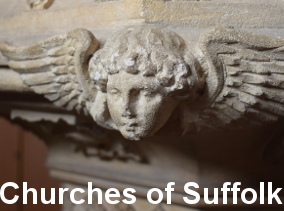
e-mail simon@suffolkchurches.co.uk
St Andrew, Gedgrave
| Gedgrave barely exists. If people know
of it, they know the name; on Orford Town Hall, the
noticeboard reads 'Orford and Gedgrave Parish Council'.
Having reached Orford, which is itself remote enough, you
take a narrow lane down beyond the castle, a mile or so
out into the marshes. Long, straight and ancient, the track runs parallel to the shore off to the east; on this day in late spring, the sky was crystal blue, and butterflies scuttered madly about the hedgerow.
Beyond here, the track becomes a footpath leading deep into the marshes, to Butley creek. There, a lone ferryman may take you across to isolated Capel St Andrew. These remaining ways are silent shadows of an ancient land, lost ghosts of the past.
Gedgrave Hall. To reach the site of St Andrew, Gedgrave, take the road down past Orford Castle from the market square. Turn right into a narrow lane, and follow it for about a mile. When you reach the end of it, St Andrew was on your left. OS map reference 405486. |